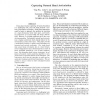Free Online Productivity Tools
i2Speak
i2Symbol
i2OCR
iTex2Img
iWeb2Print
iWeb2Shot
i2Type
iPdf2Split
iPdf2Merge
i2Bopomofo
i2Arabic
i2Style
i2Image
i2PDF
iLatex2Rtf
Sci2ools
ICCV
2001
IEEE
2001
IEEE
Capturing Natural Hand Articulation
Vision-based m,otion captu.ring of hand articulation i s - a ch,allengin,g task, since th,e hand presents a m,otion of high, degrees of freedom.. Model-based approach,es could he taken to approach this problem. by searching in, 0. h,igh dim.en,sional hand state ,sppace, a,nd m,atch,in,g projection,s of a hand m,odel and im,age ohsemiation.s. fIouieaer, it is h,a,qhhj ineficien,t due to th,e curse of dim.ension,ality. Fortumately, nmturd h,and nrticu.lation is highly constrained, iihich, lar9ely redu.ces the dim,ension,nlity of hand .state space. Th'is paper presen,ts n, m.odel-hased m,ethod to captu.re h,an.d articu.lation, by leamin,g h,o,n.d nmturd constmin,ts. Our study sh,ouis th,at natu,ro.l h,an,d articu.lo.tion lies in a lower dimfension,nl config,u.ration,sspace charoxterized by a maon, of linenr m,an,ifolds spnn,n,ed by 0. set of basis con~jigu.ration,s. By inte,qratin,g h,o,n,d m,otion, constrain,ts, an, efficien,t articirlnted m.otion,-co,pturin,,qalgorithm, is propose...
Computer Vision | Dim.en | Hand .state Space | Hand Articulation | Hand M | ICCV 2001 | Sional Hand State |
| Added | 15 Oct 2009 |
| Updated | 15 Oct 2009 |
| Type | Conference |
| Year | 2001 |
| Where | ICCV |
| Authors | Ying Wu, John Y. Lin, Thomas S. Huang |
Comments (0)

